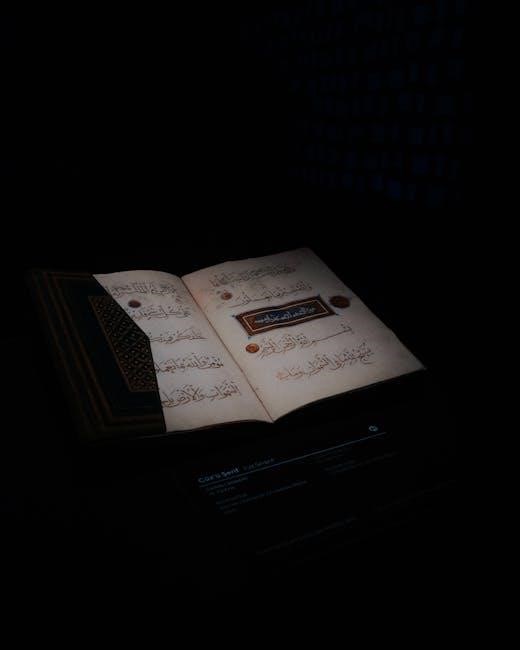The Quran is the holy book of Islam‚ written in Arabic‚ with a unique linguistic style. Studying Quranic words in English helps bridge the gap between Arabic text and its deeper meanings‚ making the divine message accessible to non-Arabic speakers while preserving its spiritual essence.
Overview of the Quran and Its Significance
The Quran is the sacred scripture of Islam‚ believed to be the literal word of God as revealed to Prophet Muhammad (peace be upon him). Comprising 114 chapters (Surahs) and approximately 77‚‚ it is written in classical Arabic‚ which is revered for its linguistic beauty and spiritual depth. The Quran serves as a guide for faith‚ worship‚ ethics‚ and law‚ making it central to Muslim life. Its significance extends beyond religious rituals‚ as it is a source of wisdom‚ comfort‚ and moral guidance. Studying Quranic words in English helps non-Arabic speakers grasp its teachings‚ fostering a deeper connection to the divine text.
Importance of Understanding Quranic Arabic
Understanding Quranic Arabic is essential for comprehending the true meaning of the Quran. The Arabic language preserves the divine message’s nuances‚ which can be lost in translation. Grasping Quranic vocabulary and grammar enhances recitation‚ reflection‚ and application of its teachings. It allows readers to engage deeply with the text‚ uncovering layers of meaning that translations may not fully capture. Additionally‚ studying Quranic Arabic fosters a stronger spiritual connection‚ enabling believers to appreciate the linguistic miracle of the Quran and apply its guidance in daily life. This foundation is vital for meaningful interaction with the holy text.

Popular Resources for Quranic Arabic Words
Leading resources include UnderstandQuran.com‚ offering focused vocabulary lists‚ and Quran Academy‚ providing comprehensive study materials. ClearQuran and Quran.com also offer integrated translation tools and detailed word studies‚ aiding learners in mastering Quranic Arabic effectively.
80 Quranic Words in English PDF
The 80 Quranic Words in English PDF is a valuable resource for learners‚ covering essential vocabulary that appears frequently in the Quran. These words account for approximately 82.6% of the total Quranic text‚ making them a foundational tool for understanding the holy book. The PDF provides clear Arabic-to-English translations‚ enabling users to grasp the meanings of key terms. It is particularly useful for beginners‚ as it simplifies the process of learning Quranic Arabic. Additionally‚ the resource often includes grammatical explanations and contextual examples‚ enhancing comprehension. This booklet is widely recommended for those seeking to build a strong vocabulary base for Quranic study.
85 Quranic Words Booklet for Understanding Arabic Grammar
The 85 Quranic Words Booklet is a comprehensive guide designed to aid in understanding Arabic grammar and vocabulary. It focuses on high-frequency words that recur throughout the Quran‚ providing their English translations and grammatical context. This booklet is structured to help learners grasp the fundamentals of Quranic Arabic‚ making it easier to comprehend longer verses. By mastering these ‚ readers can build a solid foundation in both vocabulary and grammar‚ enabling a more profound connection with the Quran’s teachings. The resource is particularly beneficial for those seeking to deepen their understanding of the Quran’s language and spiritual message.
ClearQuran: A Reliable Source for Arabic and English Text
ClearQuran is a trusted platform offering accurate Arabic text of the Quran alongside its English translation. It provides word-by-word translations‚ tafsir‚ and recitations‚ making it a valuable resource for both learners and scholars. The interface is user-friendly‚ supporting multiple languages and devices. ClearQuran is considered a Sadaqah Jariyah‚ benefiting millions worldwide. It ensures accessibility to the Quran’s teachings‚ facilitating deeper understanding and reflection. The platform’s integration of Arabic and English texts‚ along with audio recitations‚ makes it an essential tool for studying the Quran in a modern‚ convenient format. Its reliability and comprehensive features make it a go-to resource for Quranic study.

Significance of Studying Quranic Words
Studying Quranic words empowers a deeper understanding of the Quran’s message‚ fostering a strong foundation in Arabic vocabulary and spiritual connection. It enhances insight into divine verses‚ enabling meaningful reflection and application.
Building a Strong Foundation in Quranic Vocabulary
Mastering Quranic vocabulary is essential for understanding the Quran’s message. Resources like the 80 Quranic Words in English PDF and the 85 Quranic Words Booklet provide a structured approach to learning key terms. These materials often include word-by-word translations‚ grammatical explanations‚ and contextual meanings‚ ensuring a solid grasp of Arabic words. By focusing on commonly recurring words‚ learners can build a robust vocabulary base‚ enabling them to comprehend Quranic verses more effectively. Such resources are particularly valuable for non-Arabic speakers‚ as they simplify complex concepts while preserving the spiritual depth of the Quran. This foundation is crucial for deeper engagement with the holy text.
Enhancing Understanding of Quranic Verses
Understanding Quranic verses becomes more profound when learners grasp the meanings of key Arabic words. Resources like the 80 Quranic Words in English PDF and the 85 Quranic Words Booklet offer word-by-word translations and grammatical insights‚ making complex verses clearer. These tools highlight recurring words and their contexts‚ enabling learners to interpret verses accurately. Additionally‚ platforms like Quran.com provide integrated translations and tafsir‚ further enriching comprehension. By leveraging these resources‚ readers can unlock the deeper meanings of Quranic text‚ fostering a more meaningful connection with the holy book. This approach ensures that the spiritual and linguistic essence of the Quran is accessible to all.
Facilitating Effective Communication of Quranic Teachings
Understanding Quranic Arabic words is essential for effectively communicating the Quran’s teachings. Resources like the 80 Quranic Words in English PDF and the 85 Quranic Words Booklet provide clear translations and grammatical explanations‚ enabling teachers and learners to convey complex concepts accurately. Platforms such as Quran.com offer integrated tools for translation and tafsir‚ making it easier to share the Quran’s message globally. These resources ensure that the divine teachings are accessible and understandable‚ fostering a deeper connection among diverse audiences. By bridging language gaps‚ they empower communities to engage with the Quran’s wisdom effectively.

Key Features of Quranic Words in English PDF
The PDF includes word-by-word translations for clarity‚ grammatical terms‚ and color-coded text to enhance comprehension of Quranic Arabic words in an organized‚ accessible format online.
Word-by-Word Translation for Clarity
The Quranic Arabic words in English PDF offers precise word-by-word translations‚ ensuring each Arabic term is clearly understood. This method provides linguistic accuracy‚ making the Quran accessible to non-Arabic speakers. By breaking down verses into individual words‚ learners can grasp meanings without ambiguity. This approach is particularly helpful for beginners‚ as it bridges the gap between Arabic text and English comprehension. The translations maintain the spiritual essence while offering a clear‚ educational tool. This resource is invaluable for those seeking to deeply connect with the Quran’s teachings through accurate and understandable language. Its structured format ensures ease of learning and reflection.
Inclusion of Grammatical Terms and Rules
The inclusion of grammatical terms and rules in the Quranic Arabic words in English PDF enhances understanding of Quranic language. These resources provide essential grammar explanations‚ enabling learners to comprehend sentence structures and word functions. By integrating foundational Arabic grammar‚ the PDF aids in deciphering complex verses. This feature is crucial for those unfamiliar with Arabic‚ offering insights into verb conjugation‚ noun forms‚ and sentence composition. The combination of vocabulary and grammar fosters a deeper connection with the Quran‚ making it easier to interpret and apply its teachings. This comprehensive approach ensures a well-rounded learning experience‚ enriching both language and spiritual growth.
Color-Coded Text for Enhanced Comprehension
The use of color-coded text in Quranic Arabic words in English PDFs enhances comprehension by visually distinguishing Arabic words‚ their translations‚ and explanatory notes. This method simplifies the learning process‚ making it easier to identify and focus on key elements. Colors highlight grammatical terms‚ recurring phrases‚ and contextual explanations‚ ensuring clarity. For instance‚ blue might denote Arabic words‚ while green underscores important notes‚ helping learners navigate complex verses. This visually organized approach reduces confusion and improves retention‚ particularly for those new to Quranic studies. By integrating color-coding‚ these resources create a user-friendly environment that facilitates deeper understanding and engagement with the Quran’s teachings.

Top PDF Resources for Quranic Words
- 80 Quranic Words in English PDF: Covers essential vocabulary‚ aiding comprehension of common terms.
- 85 Quranic Words Booklet: Focuses on grammar and translation‚ ideal for learners.
- UnderstandQuran.com: Offers focused lists and tools for effective Quranic word study.
Quran Academy: Comprehensive Study Materials
The Quran Academy provides extensive resources for studying Quranic Arabic‚ including PDF materials that offer word-by-word translations and grammatical explanations. These documents are designed to help learners understand the language of the Quran deeply. The Academy’s resources are known for their clarity and structure‚ making them accessible to both beginners and advanced students. They emphasize common Quranic words and their meanings‚ along with practical exercises to reinforce learning. This makes the Quran Academy a trusted destination for those seeking to master Quranic Arabic and apply it to their spiritual and academic pursuits effectively.
UnderstandQuran.com: Focused Vocabulary Lists
UnderstandQuran.com offers curated vocabulary lists tailored to help learners master Quranic Arabic. Their resources include PDF guides that highlight frequently occurring words in the Quran‚ breaking them down with English translations and contextual meanings. This approach ensures learners grasp the most common terms‚ building a strong foundation for deeper understanding. The site’s materials are praised for their simplicity and effectiveness‚ making Quranic study more accessible. By focusing on high-frequency words‚ UnderstandQuran.com helps students progress efficiently in their journey to comprehend the Quran’s language and message.
Quran.com: Integrated Translation and Tafsir Tools
Quran.com stands out as a comprehensive platform offering integrated tools for studying the Quran. It provides word-by-word translations alongside tafsir (commentary)‚ enabling users to connect Arabic text with English meanings seamlessly. The platform also includes audio recitations and search functions‚ making it a versatile resource for both beginners and advanced learners. Quran.com’s integration of translation and tafsir tools helps users understand not just the literal meaning of words but also their spiritual and contextual significance. This holistic approach makes it an invaluable resource for anyone seeking to deepen their understanding of the Quran in multiple languages.

Understanding Quranic Vocabulary
Understanding Quranic vocabulary enhances comprehension of the Quran’s message. Resources like 80 Quranic Words in English PDF provide essential word lists‚ aiding learners in grasping Arabic meanings and their spiritual significance.
Commonly Recurring Words in the Quran
The Quran contains a core vocabulary of recurring words that form its linguistic foundation. These words‚ such as “Allah‚” “Rabb‚” and “deen‚” appear frequently and carry deep spiritual significance. Resources like the 80 Quranic Words in English PDF highlight these essential terms‚ which account for approximately 82.6% of the Quran’s total words. Understanding these high-frequency terms is crucial for grasping the Quran’s message. They often represent central concepts like worship‚ guidance‚ and righteousness. Studying these words enhances comprehension and facilitates deeper engagement with the Quran’s teachings‚ making them indispensable for learners of Quranic Arabic.
Contextual Meanings of Quranic Terms
Contextual meanings of Quranic terms are vital for accurate interpretation. Arabic words often carry multiple meanings depending on their usage‚ and the Quran’s context is essential for understanding their specific connotations. Resources like the 85 Quranic Words Booklet provide detailed explanations‚ ensuring learners grasp the nuances. For instance‚ words like “sabr” (patience) or “rahma” (mercy) have layered meanings that resonate differently in various verses. Without context‚ interpretations may diverge‚ leading to misunderstandings. Thus‚ studying these terms within their Quranic framework is crucial for a deeper and more accurate understanding of the divine message‚ enhancing both personal reflection and scholarly analysis.
Arabic-English Dictionaries for Quranic Study
Arabic-English dictionaries are indispensable tools for Quranic study‚ offering precise meanings of Quranic words. These resources‚ such as the Arabic-English Quranic Dictionary‚ provide multiple meanings for complex terms‚ ensuring accuracy. They often include examples from the Quran‚ aiding learners in understanding context. Such dictionaries are particularly useful for non-Arabic speakers‚ helping them decipher challenging vocabulary. By combining linguistic expertise with spiritual insights‚ these tools facilitate a deeper connection with the Quran’s message‚ making them essential for both personal study and academic research. They bridge the linguistic gap‚ enabling a more profound comprehension of the holy text’s teachings and significance.

Translation and Interpretation Aids
Translation aids like word-by-word English translations and tafsir tools simplify understanding the Quran. Resources such as ClearQuran and official translations provide clarity‚ bridging the gap between Arabic and English effectively.
Official English Translations of the Quran
Official English translations of the Quran provide a reliable means to understand the Arabic text. Translators like Maulana Sher Ali and Dr. Nazeer Ahmed ensure accuracy‚ preserving the original’s spiritual essence. These translations use modern English vocabulary‚ making them accessible while maintaining the Quran’s linguistic richness. They often include footnotes for clarification and adhere to standard regulations‚ avoiding additions not in the Arabic. Such works are essential for non-Arabic speakers‚ offering a faithful representation of the Quran’s message while respecting its linguistic and cultural nuances‚ ensuring the divine text remains comprehensible and impactful worldwide.
Modern Interpretations for Easy Understanding
Modern interpretations of the Quran aim to simplify its message for contemporary readers. Translations like those by Talal Itani use clear‚ modern English to convey the Quran’s meanings accurately. These interpretations often include word-by-word breakdowns‚ grammatical explanations‚ and contextual notes to enhance comprehension. Digital formats‚ such as PDFs‚ make these resources easily accessible. Color-coded texts and interactive tools further aid learners in grasping complex Arabic terminology. These innovations ensure the Quran’s teachings remain relevant and understandable for a global audience‚ blending tradition with modern accessibility while maintaining the sacred text’s integrity and spiritual depth.
Comparative Analysis of Different Translations
A comparative analysis of Quran translations reveals diverse approaches to conveying Arabic meanings in English. Translators like Yusuf Ali and Muhammad Asad offer distinct styles‚ with some prioritizing literal accuracy and others focusing on fluid readability. These variations highlight the challenges of translating nuanced Arabic terminology. Modern translations‚ such as those by Talal Itani‚ blend accessibility with fidelity to the original text. Resources like the “80 Quranic Words in English PDF” provide word-by-word comparisons‚ aiding learners in understanding subtle differences; Such analyses are invaluable for grasping the Quran’s depth and ensuring its message resonates across linguistic and cultural boundaries.

Learning Tools and Platforms
Utilize online platforms like Quran.com and mobile apps such as Quran Majeed for interactive learning. Explore multimedia resources‚ including videos and podcasts‚ to supplement your study of Quranic vocabulary with practical applications and community support.
Online Resources for Quranic Word Study
Online platforms like Quran.com and UnderstandQuran.com provide comprehensive tools for studying Quranic words in English. These resources offer word-by-word translations‚ grammatical explanations‚ and interactive features to enhance learning. ClearQuran is another reliable source‚ offering a side-by-side Arabic-English format with color-coded text for better comprehension. Additionally‚ websites like QuranAcademy provide downloadable PDFs and booklets‚ such as the popular “85 Quranic Words” guide‚ which simplifies understanding Arabic grammar. These online tools cater to diverse learning styles‚ making Quranic vocabulary accessible to learners worldwide. They also include audio recitations and tafsir tools to deepen the study experience.
Mobile Apps for Learning on the Go
Mobile apps have revolutionized the study of Quranic Arabic words‚ offering convenience and accessibility. Apps like Quran Academy and UnderstandQuran provide interactive tools‚ word-by-word translations‚ and audio recitations. Features such as flashcards‚ quizzes‚ and grammar guides help learners master vocabulary. Some apps‚ like Quran.com‚ integrate tafsir and translations‚ while others focus on memorization aids. These apps cater to diverse learning styles‚ enabling users to study Quranic words anytime‚ anywhere. They also often include social features‚ allowing learners to connect and share progress. Mobile apps are invaluable for modern students seeking to deepen their understanding of Quranic language on the go.
Interactive Flashcards and Quizzes
Interactive flashcards and quizzes are dynamic tools for mastering Quranic Arabic words. Apps like Quran Academy and UnderstandQuran offer digital flashcards with Arabic words‚ their English translations‚ and usage examples. Quizzes test comprehension‚ reinforcing vocabulary retention. These tools often include progress tracking‚ rewards‚ and customizable decks. They cater to all learning levels‚ from beginners to advanced students. Flashcards focus on high-frequency words‚ while quizzes assess understanding of grammar and context. Such interactive methods make learning engaging and effective‚ complementing PDF resources for a well-rounded study experience. They are ideal for learners seeking to enhance their Quranic vocabulary in a fun and challenging way.

Challenges in Translating Quranic Words
Translating Quranic words is complex due to Arabic’s nuanced context and depth. English often lacks equivalents for spiritual terms‚ requiring creative yet faithful interpretations to preserve meaning.
Limitations of English in Conveying Arabic Nuances
English often struggles to capture the richness of Arabic‚ particularly in Quranic language. Words like rahma (mercy) or haqq carry layered meanings that English can’t fully replicate. Arabic’s grammatical flexibility and context-dependent vocabulary add complexity‚ making direct translation challenging. For instance‚ the term sakina embodies spiritual tranquility‚ a concept without a direct English counterpart. This limitation necessitates explanatory notes or paraphrasing to retain the original essence‚ ensuring the spiritual depth of the Quran isn’t lost in translation.
Maintaining the Spiritual Essence in Translation
Maintaining the spiritual essence in translating Quranic Arabic words into English is paramount. The Quran’s divine message relies on preserving its emotional and spiritual depth‚ which can be lost in translation. Translators often use explanatory notes and poetic language to convey the original Arabic’s subtleties. For example‚ the word tawbah (repentance) carries a profound spiritual significance that goes beyond its literal meaning. By carefully selecting English terms and providing contextual explanations‚ translators ensure that the heart of the Quran’s message remains intact‚ allowing readers to connect with its spiritual truths despite linguistic barriers.
Addressing Ambiguities in Word Meanings
Addressing ambiguities in Quranic word meanings is crucial for accurate understanding. Certain Arabic terms have multiple connotations‚ making direct translation challenging. For instance‚ the word salah can mean both “prayer” and “blessing‚” depending on context. To resolve such ambiguities‚ scholars use tafsir (commentaries) and hadith (Prophetic traditions) to clarify meanings. Additionally‚ modern resources like the 80 Quranic Words in English PDF provide word-by-word explanations‚ ensuring that readers grasp the intended sense. This approach helps mitigate misunderstandings and enhances the clarity of Quranic teachings in English translations‚ fostering a deeper connection with the text.
Advanced Topics in Quranic Vocabulary
Exploring the etymology of Quranic terms reveals their historical and linguistic roots. Understanding the evolution of Arabic language nuances enhances comprehension of complex vocabulary and specialized terms across surahs.
Etymology of Quranic Terms
The etymology of Quranic terms offers insights into their historical and linguistic origins. Many words trace back to classical Arabic roots‚ providing deeper spiritual and cultural context. Understanding these origins enhances comprehension of complex vocabulary and reveals how meanings have evolved over time. This study also highlights how certain terms were refined or redefined within the Quranic narrative to convey specific divine messages. By exploring etymology‚ readers can uncover layers of meaning that might otherwise remain obscured‚ enriching their connection to the text. This approach bridges history‚ language‚ and faith‚ making the Quran’s timeless wisdom more accessible to scholars and learners alike.
Evolution of Quranic Language Over Time
The Quranic language‚ revealed over 23 years‚ reflects a dynamic evolution tailored to its audience and context. While its core message remained consistent‚ its expression adapted to address varying societal needs and spiritual depths. The Quran’s language laid the foundation for Classical Arabic‚ influencing Islamic scholarship and literature. Over time‚ interpretations and translations emerged to bridge linguistic gaps‚ ensuring its teachings remained accessible. Despite this evolution‚ the Quran’s original text has remained unchanged‚ preserving its divine authenticity. This enduring quality underscores its universal relevance‚ allowing it to resonate with diverse cultures and generations. Its language continues to inspire and guide‚ transcending time and borders.
Specialized Vocabularies in Different Surahs
Different surahs of the Quran employ specialized vocabularies tailored to their themes and audiences. For instance‚ earlier Makkan surahs focus on belief and morality‚ using simple‚ evocative language. In contrast‚ Madinan surahs address legal and social matters‚ incorporating more complex terms. This variation enriches the Quran’s linguistic diversity‚ making each surah unique in its approach. By studying these specialized vocabularies‚ readers gain deeper insights into the Quran’s messages and contexts. This linguistic adaptability ensures the Quran remains a timeless guide‚ addressing the spiritual and practical needs of believers across different eras and cultures‚ while maintaining its core unity and coherence.

Future Trends in Quranic Word Resources
Future trends include advanced digital tools‚ AI-driven platforms‚ and global accessibility‚ enhancing Quranic word study through interactive‚ multilingual‚ and visually enriched resources for deeper engagement.
Digital Innovations in Quranic Study
Digital innovations are transforming Quranic study‚ offering interactive tools and apps. PDF resources like “80 Quranic Words” and “85 Quranic Words Booklet” provide word-by-word translations and grammar guides‚ aiding learners. Platforms such as Quran.com and ClearQuran integrate Arabic text with English translations and tafsir‚ making study comprehensive. Mobile apps enable on-the-go learning‚ while features like color-coded texts enhance comprehension. These tools not only simplify language barriers but also ensure accessibility‚ fostering a deeper understanding of Quranic vocabulary and its spiritual significance for a global audience.
AI-Driven Tools for Vocabulary Learning
AI-driven tools are revolutionizing Quranic vocabulary learning by offering personalized and adaptive platforms. These tools analyze individual progress‚ providing tailored lessons and exercises. Interactive flashcards‚ quizzes‚ and games make learning engaging and effective. AI-powered apps can pronounce Quranic words accurately‚ helping users improve their diction. Additionally‚ AI-generated insights highlight frequently used words and their contexts‚ enhancing retention. These innovations ensure that learners can master Quranic Arabic efficiently‚ bridging the gap between traditional and modern methods of study. The integration of AI technology is making Quranic education more accessible and dynamic for learners worldwide.
Global Access to Quranic Resources
The advent of digital technology has made Quranic resources universally accessible. PDFs containing Quranic words in English are widely available online‚ enabling learners worldwide to study the Holy Book. Platforms like Quran.com and UnderstandQuran.com offer free resources‚ including word lists and translation tools. Mobile apps provide offline access‚ ensuring that even those without internet can benefit. This global accessibility fosters a unified understanding of the Quran‚ transcending geographical and linguistic barriers. The ease of downloading and sharing these resources has created a connected community of learners‚ enriching their spiritual journey and deepening their connection to the Quran’s teachings.


















































